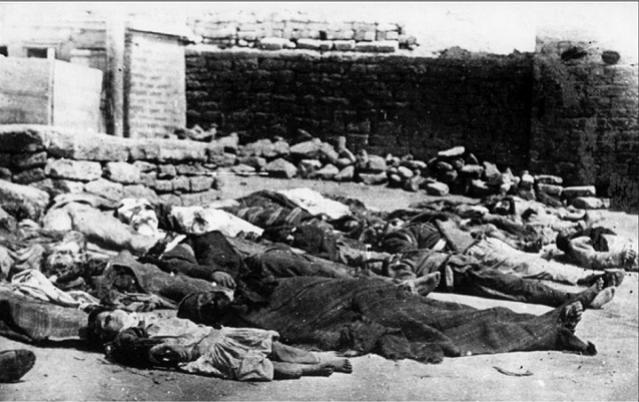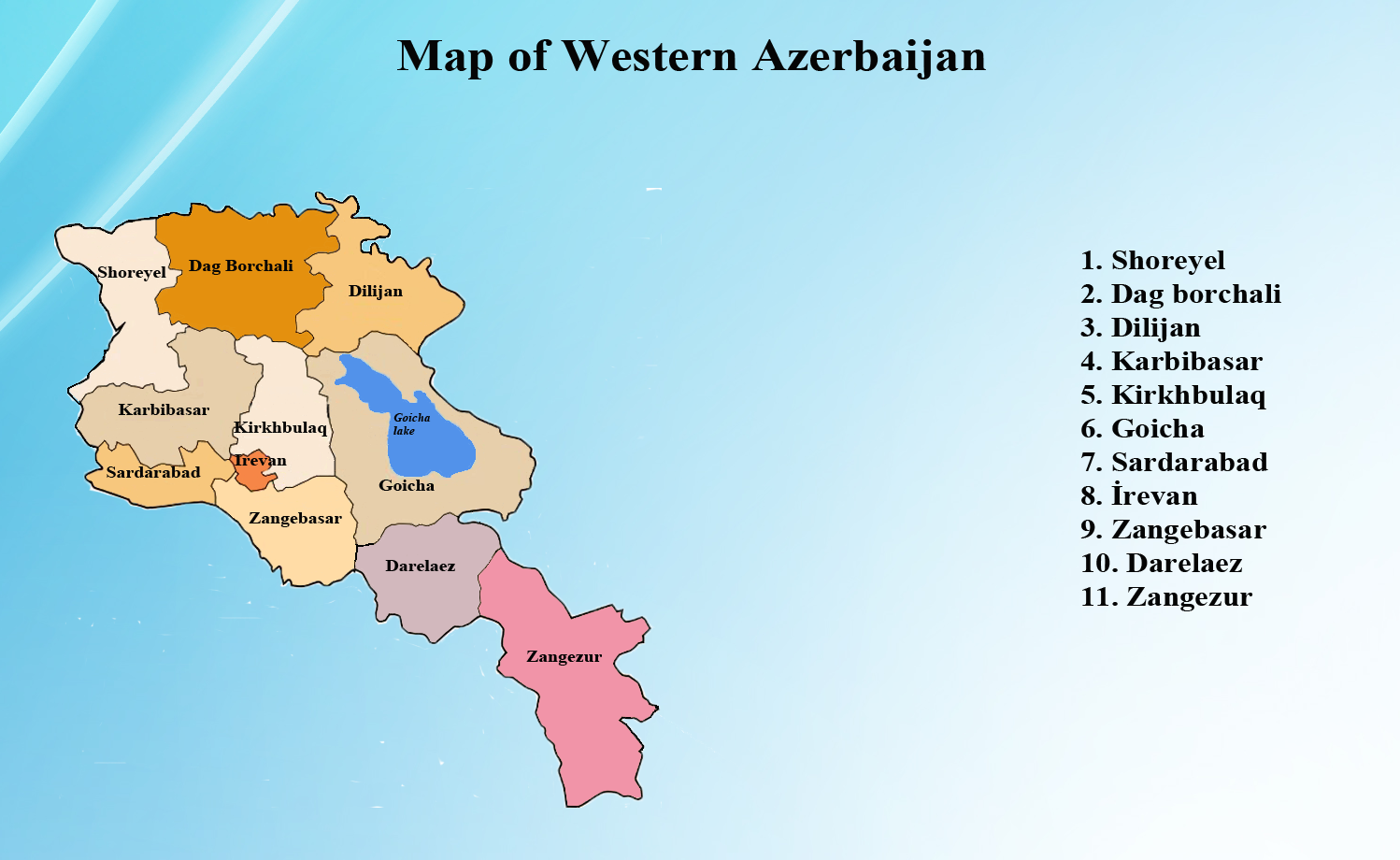1905-1906 years massacres
The Armenians who didn’t miss the opportunity to take the advantage of unrests in Russia in 1905-1906, committed on a mass scale massacres against Azerbaijani civilians in Baku, Irevan, Yelizavetepol (Ganja) and Tiflis. The Armenian armed forces wanted to put the foundation of the future “Great Armenia”state by killing the Azerbaijanis populated in Irevan-Nakhchivan – Zengazur- Karabakh and Gazakh-Ganja territories, driving them out from their historical lands and settling the Armenians in those areas. In the 90s of XIX century after the suppression of the Armenian rebellion in the territory of Turkey, more than 400 thousand Armenians (many of them were armed) fled to the South Caucasus at the instigation of foreign powers. Armenian Church, the Armenian political parties together with the Armenian intelligentsia had found the “solution” of settling Armenian refugee families: to drive out the Azerbaijanies from their historical lands and to commit massacres by force of arms, and to settle the Armenian families in the vacated territories. On the basis of received letters the “Kaspi” newspaper reporter wrote that during that period the Armenians had decided to oppresss and drive out all Muslims from Irevan province and in their placecs to settle the Armenians who moved from Turkey. According to the results of All-Russian census held in the year of 1897, Turks had settled in 959 villages out of 1301existing in the Irevan province, while Armenians in 342. In 151 villages out of 221 in the Irevan district including Irevan city the Turks, in 55 villages the Armenians, in 15 ones Armenians and Turks lived in a mixed way. Irevan city was surrounded by Azerbaijani villages on either side. Therefore, the massacres committed by Armenians starting from Irevan continued in surrounding areas.

The result of the researches shows that in 1905-1906 years more than ten thousand armed Armenian units committed massacres in Baku and its surrounding villages, in the city of Irevan, Echmiadzin (Uchkilse), Sherur-Daralayaz and Nakhchivan provinces, in Gorus (Yelizavetpol (Ganja) province), Gapan (Gafan) and Garakilse (Sisiyan), Shusha, Javanshir , Jabrayil and Gazakh regions, in the city of Tiflis and Borchali, devastated more than 200 settlements.
Genocide in 1918-1920
During the First World War when the Russian army attacked Eastern Anatolia to seize it, there were 150 thousand Armenian soldiers fighting with them who did their military service in the Russian army. Moreover, 4 armed Armenian workers detachments uniting approximately 10 thousand voluteers in themselves joined the Russian troops with the blessing of Armenian Echmiadzin Church moving through the territory of South Azerbaijan ( through Khoy, Urmia, Salmas provinces) and Kars province. Taking an opportunity, the armed destroyed the Azerbaijani and Turkish villages on the ways they passed through and killed people without exception.
As a result of the coup d’etat in Russia in November 1917, the Russian troops withdrew from Eastern Anatolia and handed over their arms and ammunition to Armenian commanders. After it, the Armenians began committing a large scaled massacres against Azerbaijanis. Starting in February 1918, Turkish troops counter-attacked the Armenian troops and mopped up the Armenians in South Anatalia. The idea of creating the Armenian state in the Irevan province and adiucent ares was put on the agenda after the collapse of Armenians’ and their supporters’intension establishing of independent Armenian state in Eastern Anatolia during the First World War. The Armenian Army withdrawing from South Anatalia under the command of Andranik, Hamazaspın, Dro, Njdeh, committed the real genocide against the Muslims in the Azrzurum and Kars provinces, then in the Irevan province and Zengezur. During this period, a large part of 350 thousand Armenians moving from Turkey settled in the Irevan province and it caused further deterioration of the Azerbaijanis’ situation living there.
The first stage of the massacre committed against the Azerbaijanis living in the Irevan province coincided with the establishment of the independent Armenian state in the historical lands of Azerbaijan. On May 26, 1918 Georgia declared its independence. At Muslim National Council meeting held on May 27, Nasib bey Yusifbeyov said that the delegation representing Turkey at Batumi conference came to conclusion that the South Caucasus had to protect its independence.
On May 28, 1918 Azerbaijan and Armenia declared their independence. In accordance with the decisionof Muslim National Council meeting held on May 29, the city of Irevan was yielded to Armenia as its political center. Members of the National Council from Irevan immediately protested against that concession. However, the decision was adopted; the vote was 16 in favour (out of 28council members), three neutral and one abstention. Though council members from Irevan Mir Hidayat Seyidov, Baghir Rizayev and Nariman bey Narimanbeyov made a written protest against the decision, it did not produce any results. To be well-informed about the alarming news coming from the Irevan province they decided to send their delegation there.
The Turkish troops cheasing the Armenian armed groups committed massacres against the Turks in Eastern Anatolia, mopped up Gumru and Boyuk Garakilse cities from the Armenians in May 1918. Though the Turkish army was in a 7 km -distance from the city of Irevan, in Ulukhanli station, they moved in the direction of Nakhchivan without entering the city. According to Batum Peace Treaty signed between Turkey and Armenia on June 4, the total area of Armenia was specified 10,000 sq.km, and population 321 thousand people (including 230 thousand Armenians, 80 thousand Muslims, 5 thousand Yezidi Kurds, 6 thousand other nations). The Novo-Bayazid district, three-fifth of the Irevan district, one quarter of the Echmiadzin district and one quarter of the Alexanrpol were included into the territory of the Armenian Republic.
The current issue on the agenda of the National Council assemly held on July 13, was the discussion about the massacre news committed by the Armenians against Muslims in Irevan. About 150 thousand Azerbaijanis were displaced from their homelands in the Irevan district territories and 206 villages were devastated.
The seizure of Zangazur by the Armenin armed groups under the command of Andiannik and the territory of Nagorno-Karabakh to be considered the disputed territory by the Armenian Government, compelled the Azerbaijan diplomacy to take adequate steps. Diplomatic representatives of Azerbaijan in Georgia notified in the letter addressed to the Armenianrepresentative in Georgia that Armenia’s claim on considering Nagorno-Karabakh to be desputed zone was regarded a breach of agreement between two parties, in its turn Azerbaijan keeps the right to declare territorial claim for Irevan city, a part Echmiyedzin, Novo-Beyazid and Irevan districts.
The second phase of massacre committed by the Armenians against the Azerbaijanis living in the territory of the Irevan province took its start after the Turkish Army’s withdrawal from the South Caucasus according to the Mudros agreement signed on October 30, 1918. The Azerbaijan Government appointed Mohammad khan Tekinsky a diplomatic representative in Armenia at the end of December. Before the diplomatic representation of Azerbaijan started functioning, Irevan Muslim National Council , Irevan Muslim Charity Society and the Irevan Province Chapter apprised Azerbijan media, officials and international organizations of the attrocities committed by the Armenians in the territory of the Irevan province. Ther condition of Muslims living in Novo-Bayazid, Echmiadzin and Irevan provinces was rather miserable. Inhuman massacres were carried out in those districts. There was a real war with bayonet attack and bombardment. The hero sons of Azerbaijan beat off Armenians attacks in”Gurd Gapisi” (“Wolf Gate”) and thanks to them only Sherur and Nakhchian remained whole.
The issue related to the status of refugees from the Zangazur district and the Irevan province was discussed at the meeting of the Azerbaijani Parliament dated July 17, 1919. At the meeting Baghir bey Rizayev said that a year ago 22 thousand Muslims lived in Irevan but most of them left the city. When few of them returned back, they found their houses and belongings to be destroyed and looted. He notified that the Armenian Government did not help the Muslim refugees.
Timur Khan Makinsky, Commissioner of the Ministry of Patronage in Armenia revealed the real face of the Armenian Government in his report sent to the Ministry of Patronage on November 11, 1919: “As a result of the ongoing massacres since February 1918, a half million people have become destitute (except Nakhchivan district, Sherur station, second and third police stations in the Sherur postand and Zengibasar region). In those areas the Azerbaijanis have lost everything. The number of the people is more than 200 thousand in the regions subjected to destruction. They are dying because of disease and starvation, and have been subjected to repeated massacres and plunders”.
At the meeting of the Azerbaijani Parliament on January 5, 1920, the issue of refugees was discussed, and it was noted that 300 thousand refugees came from Armenia. After the Bolsheviks seized the power in Azerbaijan in April 1920, the Dashnak government took a good opportunity from the situation and a new phase of massive massacres against Azerbaijanis started. 14 thousand people in Irevan city with a population of 29 thousand, 4 thousand in the Echmiadzin district died of starvation during 6 months in 1919. Of course, in the vast majority of those who died of starvation were Azerbaijanis. At that time the Azerbaijanis could not go out of their homes, so they were “condemned” to death. In general, during 1918-1920 years 58 in Shamakhi district, 112 in Guba district, 323 in the Ganja province (including 166 in Zagazur, 157 in Karabakh), 300 in the Irevan province, in the Kars region 82 settlements were razed to ground, hundreds of thousands Azerbaijanis were killed, around one million people were displaced from their ethnic-historical homelands by the Armenian armed forces. Generally, in 1905-1920 years over 500 Azerbaijani villages in the present Armenia territory were destroyed, and most of them turned to the Armenian settlements.
Though in 1916 the number of the Azerbaijanis living in the Irevan province was 373,582, in November 1920 in Armenia SSR just 12 thousand Azerbaijanis were registered. After the establishment of Soviet power in Armenia, a small part of Azerbaijanis could return to their homes. However, in 1922, there were only 5.124 Azerbaijanis in Irevan , the number of Armenians reached 40.396. In other words, in 1918-1920 years the number of Azerbaijanis decreased by 2.5 times, while the number of Armenians increased approximately 4 times.
To come to the conclusion that genocide was committed against Azerbaijanis in the true sense of the word, in Armenia in 1918-1920 years, there is sufficient evidence in archives and the media of that time.
For the purpose of legal-political assesment of genocide and deportation actions committed by Armenians against Azerbaijanis in XIX-XX centuries, President of the Republic of Azerbaijan signed a Decree “On Genocide of Azerbaijanis” on March, 1998 and in order to commemorate all the tragedies of the genocide March 31 was declared the Genocide Day of the Azerbaijanis.
Deportation of Azerbaijanis from Armenia in 1948-1953
While the Soviet-Iranian relations were focused in Tehran conference in 1943, Armenian Diaspora asked V.Molotov, the Minister of Foreign Affairs of USSR to deport Armenians living in Iran to the USSR. V.Molotov informs I.Stalin, the chairman of CC CP of the USSR about this matter which had later been approved. Basing on this fact G. Aroutyunov, the secretary of the Central Committee of the Armenia Communist Party strived for taking of the decision about forceful deportation of Azerbaijanis on the pretext of Armenians’ migration living abroad to Armenia.
On December 23, 1947 the Soviet of the Ministries of the USSR took the decision “About deportation of collective-farmers and other Azerbaijanis from Armenia SSR to Kur-Araz lowland in Azerbaijan SSR’”.
The matter focused by the Armenians on the next deportation ruled by Stalin in 1948-1953, was to vacate economically, socially and morally strong and strategic areas of Azerbaijan. The first stage in this process was the vacation Azerbaijanis from the territories near around Iravan city (today’s Yerevan) and then from the center of the regions, surrounding villages and settlements.
Part of the deported population lived on the mountainous part of Armenia, so to get used to the climate of the Kur-Araz lowland was very difficult for them. That was why, many of 10 thousands of people migrated to the Kur-Araz, died.
On the other hand, no Azerbaijani deported from Armenia was permitted to pass to the territory of Daghlig Garabagh (Nagorno Karabakh). This territory was planned to be cleaned from the Azerbaijanis in the way of realization of “The Great Armenia” idea and thus, in 1949 under the name of the inner migration 132 families (549 individuals) were deported from Nagorno Karabakh to Khanlar region of Azerbaijan.
At the same time the names of Azerbaijan places of settlement were changed, educational and cultural centers were closed, the regions were joined. In 1947-1953 the names of 60 places of the settlement of Azerbaijanis were changed. Generally, hundreds of places of Turkish settlements were changed by Armenians during 1921-1988.
In the process of the deportation the Armenians used the trick: they kept small quantity of Azerbaijanis in the region and the cities. Those remained in minority were once and for all deported from the country in the next stage of the plan-the total vacation of Armenia from the Azerbaijanis.
Deportation of the Azerbaijanis from Armenia in 1988-1989
Since the January of 1988 the policy of ‘Armenia without Turkish’ had been realized in planned form. Under the guardianship of USSR, the government of Armenia, the committees of ‘Karabakh’ and ‘Krunk’, the members of the church of Echmiadzin participated in thousands of bloody actions in the process of the deportation of the Azerbaijanis.
185 places of the settlement in Armenia were vacated, more that 250. 000 Azerbaijanis and 18. 000 Kurds were forcefully deported from their houses and 217 Azerbaijanis were murdered by the Armenians in the result of ethnical clearance. 49 of them froze in the mountains when they tried to escape, 35 were killed under torture, 115 were burnt and 16 were shot, 10 could not bare the torture and died from heart attack, 2 were murdered by the doctors in the hospitals, the rest were drown, hanged, killed under electricity, others’ heads were cut off.
Source:
Yagub Mahudov, Karim Shukurov Garabagh – Real history, facts, documents, Baku-2005
Nazim Mustafa , The city of Irevanİrəvan Baku – 2013




